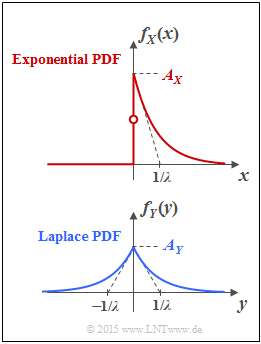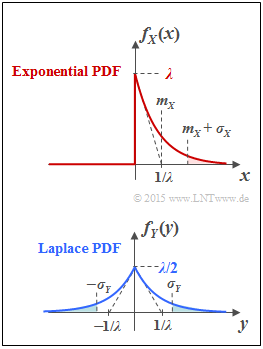Exercise 4.1Z: Calculation of Moments
The upper graph shows the probability density function $\rm (PDF)$ of the exponential distribution:
- $$f_X(x) = \left\{ \begin{array}{c} A_{ X} \cdot {\rm e}^{-\lambda \hspace{0.05cm} \cdot \hspace{0.05cm}x} \\ A_{ X}/2 \\ 0 \\ \end{array} \right. \begin{array}{*{20}c} {\rm{f\ddot{u}r}} \hspace{0.1cm}x>0, \\ {\rm{f\ddot{u}r}} \hspace{0.1cm}x=0, \\ {\rm{f\ddot{u}r}} \hspace{0.1cm}x<0. \\ \end{array}$$
Drawn below is the PDF of the Laplace distribution, which can be specified for all $y$–values as follows:
- $$f_Y(y) = A_{ Y} \cdot {\rm e}^{-\lambda \hspace{0.05cm} \cdot \hspace{0.05cm} |\hspace{0.03cm}y\hspace{0.03cm}|}\hspace{0.05cm}.$$
The two continuous random variables $X$ and $Y$ are to be compared with respect to the following characteristics:
- The linear mean $m_1$ (first order moment),
- the second order moment ⇒ $m_2$,
- the variance $\sigma^2 = m_2 - m_1^2$ ⇒ Steiner's theorem,
- the standard deviation $\sigma$.
Hints:
- The task belongs to the chapter Differential Entropy.
- Useful hints for solving this task and further information on continuous random variables can be found in the third chapter "Continuous Random Variables" of the book Theory of Stochastic Signals.
- Also given are the two indefinite integrals:
- $$\int \hspace{-0.01cm} x \cdot {\rm e}^{-\lambda \hspace{0.05cm}\cdot \hspace{0.05cm}x}\hspace{0.1cm}{\rm d}x = \frac{{\rm e}^{-\lambda \hspace{0.05cm}\cdot \hspace{0.05cm}x}}{(-\lambda)^2}\cdot(-\lambda \cdot x-1)\hspace{0.05cm}, $$
- $$\int \hspace{-0.01cm} x^2 \cdot {\rm e}^{-\lambda \hspace{0.05cm}\cdot \hspace{0.05cm}x}\hspace{0.1cm}{\rm d}x = {\rm e}^{-\lambda \hspace{0.05cm}\cdot \hspace{0.05cm}x}\cdot (\frac{x^2}{-\lambda} - \frac{2x}{\lambda^2} + \frac{2}{\lambda^3}) \hspace{0.05cm}. $$
Questions
Solution
- The area under the PDF must always be $1$ . It follows for the exponential distribution:
- $$A_{X} \cdot\int_{0}^{\infty} \hspace{-0.01cm} {\rm e}^{-\lambda \hspace{0.05cm}\cdot \hspace{0.05cm}x}\hspace{0.1cm}{\rm d}x = A_{X} \cdot (-1/\lambda)\cdot\big [{\rm e}^{-\lambda \hspace{0.05cm}\cdot \hspace{0.05cm}x}\big ]_{0}^{\infty} = A_{X} \cdot (1/\lambda) \stackrel{!}{=} 1 \hspace{0.3cm} \Rightarrow\hspace{0.3cm} A_{X} = \lambda \hspace{0.05cm}. $$
(2) Proposed solution 1 is correct:
- From the graph on the information page, we can see that the height $A_Y$ of the Laplace PDF is only half as large as the maximum of the exponential PDF:
- $$A_Y = \lambda/2.$$
(3) Correct is YES, although for $z \ne 0$ always $f_X(z) = f_Y(z)$. Let us now consider the special case $z= 0$:
- For the Laplace PDF: $f_Y(y = 0) = \lambda/2$.
- For the exponential PDF, the left-hand and right-hand limits differ for $x \to 0$.
- The PDF value at point $x= 0$ is the average of these two limits:
- $$f_X(0) = \frac{1}{2} \cdot \big [ 0 + \lambda \big] = \lambda/2 = f_Y(0)\hspace{0.05cm}.$$
(4) All proposed solutions are correct.
For the exponential distribution, the $k$–th order moment is generally calculated to be
- $$m_k = \frac{k!}{\lambda^k} \hspace{0.3cm}\Rightarrow\hspace{0.3cm} m_1 = \frac{1}{\lambda}, \hspace{0.3cm} m_2 = \frac{2}{\lambda^2}, \hspace{0.3cm} m_3 = \frac{6}{\lambda^3}, \ \text{...}$$
Thus one obtains for
- the linear mean (first order moment):
- $$m_1 = \lambda \cdot\int_{0}^{\infty} \hspace{-0.01cm} x \cdot {\rm e}^{-\lambda \hspace{0.05cm}\cdot \hspace{0.05cm}x}\hspace{0.1cm}{\rm d}x = \lambda \cdot \left [\frac{{\rm e}^{-\lambda \hspace{0.05cm}\cdot \hspace{0.05cm}x}}{(-\lambda)^2}\cdot(-\lambda \cdot x-1)\right ]_{0}^{\infty}= {1}/{\lambda} \hspace{0.05cm},$$
- the second order moment:
- $$m_2 = \lambda \cdot\int_{0}^{\infty} \hspace{-0.01cm} x^2 \cdot {\rm e}^{-\lambda \hspace{0.05cm}\cdot \hspace{0.05cm}x}\hspace{0.1cm}{\rm d}x = \lambda \cdot\left [ {\rm e}^{-\lambda \hspace{0.05cm}\cdot \hspace{0.05cm}x}\cdot (\frac{x^2}{-\lambda} - \frac{2x}{\lambda^2} + \frac{2}{\lambda^3}) \right ]_{0}^{\infty} ={2}/{\lambda^2} \hspace{0.05cm}.$$
From this, using Steiner's theorem for the variance of the exponential distribution, we get:
- $$\sigma^2 = m_2 - m_1^2 = {2}/{\lambda^2} -{1}/{\lambda^2} = {1}/{\lambda^2} \hspace{0.3cm} \Rightarrow\hspace{0.3cm} \sigma = {1}/{\lambda}\hspace{0.05cm}.$$
(5) Only the proposed solution 2 is correct:
- The second moment of "Laplace" is the same as for the exponential distribution because of the symmetric PDF:
- $$m_2 = \frac{\lambda}{2} \cdot \int_{-\infty}^{\infty} \hspace{-0.01cm} y^2 \cdot {\rm e}^{-\lambda \hspace{0.05cm}\cdot \hspace{0.05cm}|y|}\hspace{0.1cm}{\rm d}y = \lambda \cdot\int_{0}^{\infty} \hspace{-0.01cm} y^2 \cdot {\rm e}^{-\lambda \hspace{0.05cm}\cdot \hspace{0.05cm}y}\hspace{0.1cm}{\rm d}y = {2}/{\lambda^2} \hspace{0.05cm}.$$
- In contrast, the mean of the Laplace distribution is $m_1 = 0$.
- Thus, the variance of the Laplace distribution is twice that of the exponential distribution:
- $$\sigma^2 = m_2 - m_1^2 = {2}/{\lambda^2} - 0 ={2}/{\lambda^2} \hspace{0.3cm} \Rightarrow\hspace{0.3cm} \sigma = {\sqrt{2}}/{\lambda}\hspace{0.05cm}.$$
(6) For the exponential distribution, according to the upper graph with $m_X = \sigma_X = 1/\lambda$:
- $${\rm Pr}( |X - m_X| > \sigma_X) \hspace{-0.05cm} = \hspace{-0.05cm} {\rm Pr}( X > 2/\lambda) \hspace{-0.05cm} = \hspace{-0.05cm} \lambda \cdot\int_{2/\lambda}^{\infty} \hspace{-0.08cm} {\rm e}^{-\lambda \hspace{0.05cm}\cdot \hspace{0.05cm}x}\hspace{0.1cm}{\rm d}x = -\left [ {\rm e}^{-\lambda \hspace{0.05cm}\cdot \hspace{0.05cm}x} \right ]_{2/\lambda}^{\infty} = {\rm e}^{-2} \hspace{0.15cm}\underline {\approx 0.135}.$$
For the Laplace distribution (lower graph), with $m_Y = 0$ and $\sigma_Y = \sqrt{2}/\lambda$ we obtain::
- $${\rm Pr}( |Y - m_Y| > \sigma_Y) = 2 \cdot {\rm Pr}( Y > \sqrt{2}/\lambda) = 2 \cdot \frac{\lambda}{2} \cdot\int_{\sqrt{2}/\lambda}^{\infty} \hspace{-0.01cm} {\rm e}^{-\lambda \hspace{0.05cm}\cdot \hspace{0.05cm}x}\hspace{0.1cm}{\rm d}x $$
- $$\Rightarrow \hspace{0.3cm}{\rm Pr}( |Y - m_Y| > \sigma_Y) = \left [ {\rm e}^{-\lambda \hspace{0.05cm}\cdot \hspace{0.05cm}x} \right ]_{\sqrt{2}/\lambda}^{\infty} = - {\rm e}^{-\sqrt{2}} \hspace{0.15cm}\underline {\approx 0.243}\hspace{0.05cm}.$$
A comparison of the shaded areas in the accompanying graph qualitatively confirms the result:
⇒ The blue areas together are slightly larger than the red area.

